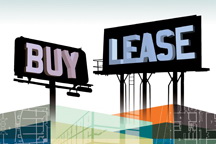 Reprinted with permission from the original author, Steve Haas
Reprinted with permission from the original author, Steve Haas
A few years ago it seemed that cheap lease programs were available from every car manufacturer. These days, the loss of captive finance arms (like GMAC for GM which is now owned by Cerberus) and the credit crunch brought about by the financial crisis may have reduced the availability of great new-car leasing programs, but they aren’t gone completely. As an example, my local paper had an ad for a 2009 Mazda3 5-door (with automatic) for a lease payment of $219 per month for three years. This sounds like a very affordable payment for a new car, especially one as universally acclaimed as the Mazda.
I believe that there is still quite a bit of mystery surrounding auto leasing and a bit of education can go a long way. The small print in the ads is often intimidating and full of unusual terminology. Additionally, unlike traditional car loans the detailed financial terms of an auto lease don’t have to be disclosed so they usually aren’t. In order to decide whether a lease is a good deal for you or not, let’s review some basics.
What is a lease?
In simple terms, when you lease a car you are paying to use it for a specific amount of time rather than buying it. As some dealers explain it, you are paying only for the portion of the car you use. In the example above, Mazda is offering the car for three years for a payment of $219/month (plus a down-payment of $2,814). This means that aside from taxes and other state fees, the lessee of this car will pay a total of $10,698 to drive the car for 36 months and 36,000 miles.
The terms of the lease are determined by a few things. First is the price of the car. This is called the “capitalized cost” in leases versus “purchase price” in regular financing. In the case of the Mazda, the base MSRP of a Mazda3 5-door automatic is $19,945. Note, however, that the capitalized cost for your lease doesn’t need to be MSRP. While many buyers are lured by the advertised payment and don’t ask many questions, if you negotiate the purchase price of the car, trade-in a vehicle on which you have equity, or take advantage of other discounts, the capitalized cost can go down… and thus your payments will as well. Of course, payments will also rise if you choose a car with more options than the one used to advertise the program or trade in a car on which you owe more than it is worth.
 The second item is the amount the car is worth (or more accurately, projected to be worth) at the end of the lease term which is called the “residual value.” The small print on this Mazda lease offer indicates that the residual value will be $11,169 or roughly 55% of the MSRP of this car new. This residual value should not change because you negotiated down the capitalized cost… it’s based on a percentage of the MSRP of the car you chose. In the early days of leasing there were situations in which the lease of the car was responsible if car was worth less than the projected amount. Those days are long gone… for at least the last 15 years this risk has been held by the financing company. This was really a win for the consumer. With the lease-end purchase price locked in by contract, if the car ends up being worth a lot more at the end of the lease you can buy it at a lower price and if it’s worth less, just turn it back in and walk away.
The second item is the amount the car is worth (or more accurately, projected to be worth) at the end of the lease term which is called the “residual value.” The small print on this Mazda lease offer indicates that the residual value will be $11,169 or roughly 55% of the MSRP of this car new. This residual value should not change because you negotiated down the capitalized cost… it’s based on a percentage of the MSRP of the car you chose. In the early days of leasing there were situations in which the lease of the car was responsible if car was worth less than the projected amount. Those days are long gone… for at least the last 15 years this risk has been held by the financing company. This was really a win for the consumer. With the lease-end purchase price locked in by contract, if the car ends up being worth a lot more at the end of the lease you can buy it at a lower price and if it’s worth less, just turn it back in and walk away.
The third component is financing cost. Unlike a regular loan in which we are all familiar with the idea of the annual percentage rate (APR) the finance cost on a lease doesn’t have to be disclosed by law. To further complicate matters, even if you do ask you will be quoted a “money factor” rather than a straight APR. This will look like some bizarre number taken down to eight to ten decimal places (In the Mazda lease it is 0.00001625 for example). If you want a full description of how this cost is calculated, check out this site: http://www.leaseguide.com/lease08.htm. If you aren’t as interested, simply know that you can multiply the money factor by 2,400 and you will have the approximate APR (the number above works out to 3.9% using this method). Also note that while you are making payments on the portion of the car you use you will be paying interest on the entire amount… after all, you are tying up the bank’s money for the full capitalized value for three years.
Your payment is then the value of the car lost during the time you drive it (capitalized cost – residual value) plus the financing fees.
Are there advantages to leasing?
In most states, there is an additional savings for lessees versus buyers – taxes. If you finance the car normally you will need to pay sales tax on the full value of the car up front. So buying a $20,000 car in a state with 6% sales tax will require you to add $1,200 to your cost up front (or included in your loan). On a lease one typically pays this sales tax only on the monthly payment… or in our example 6% of $219 or roughly $13/month or $473 over the term of the lease. If you don’t plan to keep the car for more than three years anyway, the additional taxes are a loss.
Perhaps the biggest advantage to leasing is a lower monthly payment. For this example I am comparing this lease program to financing offered on the same car by Mazda at 3.9% over 5 years. I’m assuming that if you qualify for the lease you will also qualify for the best available finance rate. I’m also assuming, for calculations sake that sales tax is 6% in your state and I am ignoring registration and title fees which would need to be paid regardless of your purchase method. I’m keeping the cash down payment (called the “capitalized cost reduction” in leasing) equal between the two methods.
| LEASE | PURCHASE | |
| MSRP |
$19,945
|
$19,945
|
| Cap Cost Reduction / Down Payment |
$2,814
|
$2,814
|
| Capitalized Cost |
$17,131
|
-
|
| Sales Tax (Financed) |
-
|
$1,196.70
|
| Amount Financed |
-
|
$18,327.70
|
| 60 Month Payment |
-
|
$311.56
|
| 36 Month Lease Payment |
$219
|
-
|
| Lease Payment + Tax | $232.14 |
-
|
| Total Cost Over Term |
$11,171.04
|
$21,507.37
|
You can see that the monthly payment is about $79 higher for a traditional purchase (34% higher than the lease) even with the great financing APR.
Is leasing a good idea for me?
Whether leasing is a good idea for you depends on a number of factors.
First, do you plan to get a new car every few years anyway? If so, leasing may save you money in taxes and reduces your monthly payment. If you live in a state with higher taxes than my example the advantage is even greater. There is definitely something positive to be said for the idea of always driving a car with a factory warranty.
Can you live with the mileage limitations of the lease? The Mazda lease is limited to 36,000 miles during the lease period (12k miles per year is considered average for an American driver, by the way). Be sure to note the mileage allowance and the fee you must pay if you exceed this amount. In the old days, the overage fees could be exorbitant (25 to 50 cents per mile, for example). Mazda’s lease program charges 15 cents per mile over, so an extra 1,000 miles/year for three years would cost you $450… pretty fair. However, if you commute 100 miles each day or plan to take numerous cross-country road trips you would be advised to think twice about leasing or ask about a lease with more miles included… this will usually lower the residual value.
 Are you comfortable knowing that you will need to make another car buying decision again in two or three years? When your lease is up you will need to turn the car back in and buy another or buy the car you just leased. Typically you can purchase the car for the agreed-upon residual value. If you find that the residual value is lower than the cost of a comparable car on the used-car market this might be a good deal for you. If it’s higher, you can just turn it back in and let the leasing company take the hit. In fact, it’s this latter example which is partly responsible for the decline in available leasing programs. The banks and captive finance companies (like GMAC and Ford Motor Credit) used lease programs to move a lot of cars over the past decade. The recent sudden decline in the resale value of SUVs, as one example, means that they were left with a lot of lease returns worth considerably less than they planned for. Of course, if you were the lessee of a Chevy Tahoe this would seem like a blessing to you… the bank was left holding the risk, you met your obligations by making the monthly payments on the lease and now just walk away from the vehicle.
Are you comfortable knowing that you will need to make another car buying decision again in two or three years? When your lease is up you will need to turn the car back in and buy another or buy the car you just leased. Typically you can purchase the car for the agreed-upon residual value. If you find that the residual value is lower than the cost of a comparable car on the used-car market this might be a good deal for you. If it’s higher, you can just turn it back in and let the leasing company take the hit. In fact, it’s this latter example which is partly responsible for the decline in available leasing programs. The banks and captive finance companies (like GMAC and Ford Motor Credit) used lease programs to move a lot of cars over the past decade. The recent sudden decline in the resale value of SUVs, as one example, means that they were left with a lot of lease returns worth considerably less than they planned for. Of course, if you were the lessee of a Chevy Tahoe this would seem like a blessing to you… the bank was left holding the risk, you met your obligations by making the monthly payments on the lease and now just walk away from the vehicle.
How important are monthly payments to your budget? In our example above for a moderately priced car with a very low 60-month finance rate the payments are lower for leasing… probably enough to cover the average monthly cable and telephone bill. Alternatively, some people choose to lease so they can drive a nicer car than they could otherwise afford.
In terms of long-term cost, however, leasing isn’t necessarily the most cost-effective choice. Assuming that you keep the car for a long time and make your payments for five years you will actually own the car. If you leased you don’t own a thing. No matter what the used Mazda will be worth in 5 years it’s safe to say that it won’t be zero. Cars do eventually wear out and get recycled, but even then there is some value to the raw materials! For comparison sake, the KBB private party value for a 2003 Mazda Protege5 (which was replaced by the Mazda3 Hatchback in Mazda’s lineup) with 60,000 miles is roughly $8,500. Assuming this Mazda 3 is worth around the same amount (though it does cost more new than the Protege5 did in its day) the cost to finance and drive the same car for 5 years then sell is only $1,800 higher than leasing it for only 3.
The outright least expensive way to own a car is to buy it and keep it until repair costs start to outweigh its value. Or, as many people prefer, to buy a car when it is already a couple of years old (perhaps being sold by the finance company after someone’s lease has ended) and it has already experienced its largest depreciation hit. However, many of us have limited budgets and lack the desire to deal with the inevitable inconveniences that come with older cars. If this describes you, leasing may provide a convenient and cost effect option now that you understand how they work.
About Steve Haas
Steve has worked in the automobile industry in one manner or another for the past 18 years. After many years in the OEM world of manufacturing and sales he helped to manage the vehicles business at eBay Motors for nearly 6. Now Steve is an independent consultant, writer, serves on the board of directors of The American Concours Foundation, and works on some new idea all the time. Oh yeah, he’s also always on the lookout for cool used cars.


Pingback: Table of Contents – Expert Reviews - suzuki 125
Hi,
We have just added your latest post “Leasing vs. Buying a New Car” to our Directory of Auto Loan . You can check the inclusion of the post here . We are delighted to invite you to submit all your future posts to the directory and get a huge base of visitors to your website.
Warm Regards
Au-toloan.info Team
http://www.au-toloan.info
Good article – nice read.
Yes, leasing works for some people. But, it can also be a headache. For one, when you go to return the vehicle when the leases ends, there’s a very good chance that you’ll have to pay for door dings, scratched rims, or any other thing deemed “beyong normal wear and tear.” I have heard of people who had to come up with $5,000 to pay for so-called “damages” to the car when they went to return it. Beware!